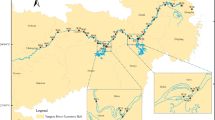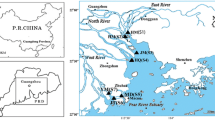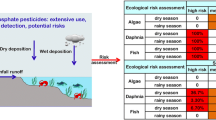Abstract
Screening-level ecological risk assessments of di(2-ethylhexyl)phthalate (DEHP) for aquatic organisms in Japan were conducted using estimated statistical values based on surface water and sediment monitoring data and effect threshold values based on a large aquatic toxicity database. An alternative method is proposed to handle monitoring data that contain nondetects including multiple detection limits and to determine the statistical values of DEHP concentrations in Japanese surface waters. The No-Observed-Effect-Concentration (NOECwater) of DEHP for aquatic life of 77 μ g/L was determined giving equal importance to both physical effects probably caused by undissolved DEHP and to the intrinsic toxicity potentially caused by DEHP. The NOECsediment of 615,000 μg/kg was determined by the Equilibrium Partitioning (EqP) theory, conservatively assuming a threshold effect level in the water column as the water solubility of 3 μ g/L. The potential risks of DEHP in Japanese water environments were characterized simply by comparing the margin of exposure (MOE) with a specified uncertainty multiplier (UM). The MOE is expressed as the ratio of NOECwater or NOECsediment to the expected environmental concentrations such as the 95th percentiles of the estimated DEHP concentration distributions for surface water or sediment. The results of risk characterization show that all MOE values calculated using the statistical values of DEHP concentrations in Japanese surface waters and sediments are above 10, indicating minimal risk. Although the DEHP concentrations of some surface water samples showed MOE values of less than 10, considering environmental chemistry such as bioavailable fractions and the form of existence of DEHP in a water environment, we conclude that the current levels of DEHP are of little concern to aquatic life in the majority of Japanese surface waters and sediments.
Similar content being viewed by others
References
Adams, W. J. and Heidolph, B. B.: 1985, ‘Short-Cut Chronic Toxicity Estimates Using Daphnia magna. In: R. D. Cardwell, R. Purdy and R. C. Bahner (eds), Aquatic Toxicology and Hazard Assessment. STP 854. ASTM, pp. 87–103.
Adams, W. J., Biddinger, G. R., Robillard, K. A. and Gorsuch, J. W.: 1995, ‘A summary of the acute toxicity of 14 phthalate esters to representative aquatic organisms’, Environ. Toxicol. Chem. 14, 1569–1574.
Birge, W. J., Black, J. A. and Bruser, D. M.: 1979, ‘Toxicity of Organic Chemicals to Embryo-Larval Stages of Fish’, University of Kentucky Water Resources Research Institute, Lexington Kentucky. Contract number 68-01-4321. Final report.
Brown, D. and Thompson, R. S.: 1982, ‘Phthalates and the aquatic environment. Part I: The effect of Di-2-ethylhexylphthalate (DEHP) and di-isodecyl phthalate (DIDP) on the reproduction of Daphnia magna and observations on their bioconcentration’, Chemosphere 11, 417–426.
Call, D. J., Markee, T. P., Geiger, D. L., Brooke, L. T., Van de Venter, F. L., Cox, D. A., Genisot, K. I., Robillard, K. A., Gorsuch, J. W., Parkerton, T. F., Reiley, M. C., Ankley, G.T. and Mount, D. R.: 2001, ‘An assessment of the toxicity of phthalate esters to freshwater benthos. 1. Qqueous exposures’, Environ. Toxicol. Chem. 20, 1798–1804.
Canada: 1994, ‘Canadian Environmental Protection Act, Priority Substances List Assessment Report Bis (2-ethylhexyl) phthalate’, Ottawa Canada, Environment Canada, Health Canada.
Carlberg, G. E., Martinsen, K., Kringstad, A., Gjessing, E., Grande, M., Kallquist, T. and Skare, J. U.: 1986, ‘Influence of aquatic humus on the bioavailability of chlorinated micropollutants in Atlantic salmon’, Arch. Environ. Contam. Toxicol. 15, 543–548.
Chiou, C. T., Kile, D. E., Brinton, T. I., Malcolm, R. L., Leenheer, J. A. and MacCarthy, P.: 1987, ‘A comparison of water solubility enhancement of organic solutes by aquatic humic materials and commercial humic acids’, Environ. Sci. Technol. 21, 1231–1234.
Day, K. E.: 1991, ‘Effects of dissolved organic carbon on accumulation and acute toxicity of Fenvalerate, Deltamethrin and Cyhalothrin to Daphnia magna (STRAUS)’, Environ. Toxicol. Chem. 10, 91–101.
DeFoe, D. L., Holcombe, G. W. and Hammermeister, D. E.: 1990, ‘Solubility and toxicity of eight phthalate esters to four aquatic organisms’, Environ. Toxicol. Chem. 9, 623–636.
DiToro, D. M., Zarba, C. S., Hanssen, D. J., Berry, W. J., Swartz, R. C., Cowan, C. E., Pavlou, S. P., Allen, H. E., Thomas, N. A. and Paquin, P. R.: 1991, ‘Technical basis for establishing sediment quality criteria for nonionic organic chemicals using equilibrium partitioning’, Environ. Toxicol. Chem. 10, 1541–1583.
European Commission: 2003, Technical Guidance Document in Support of Commission Directive 93/67/EEC on Risk Assessment for New Notified Substances. Commission Regulation (EC) 1488/ 94 on Risk Assessment for Existing Substances and Directive 98/8/EC of the European Parliament and of the Council Concerning the Placing of Biocidal Products on the Market. Ispra, Italy, p. 328.
EU: 2001, ‘Risk Assessment Bis(2-ethylhexyl)phthalate, Consolidated Final report: September 2001, Chapters 0–3’, European Chemicals Bureau.
Fliedner, A.: 1997, ‘Ecotoxicity of poorly water-soluble substances’, Chemosphere 35, 295–305.
Haitzer, M., Höss, S., Traunspurger, W. and Steinberg, C.: 1998, ‘Effects of dissolved organic matter (DOM) on the bioconcentration of organic chemicals in aquatic organisms – A review’, Chemosphere 37, 1335–1362.
Hodge, V. A., Fan, G. T., Solomon, K. R., Kaushik, N. K., Leppard, G. G. and Burnison, B. K.: 1993, ‘Effects of the presence and absence of various fractions of dissolved organic matter on the toxicity of fenvalerate to Daphnia magna’, Environ. Toxicol. Chem. 12, 167–176.
HSDB: 2001, Hazardous Substances Data Bank, U.S. National Library of Medicine, MD, USA.
IPCS: 2002, International Chemical Safety Cards, available at http://www.jlo.org/public/english/ protection/safework/cis/products/icsc/index.html (Oct. 18, 2004).
Japan Chemical Industry Association: 2002, ‘Research on monitoring and distribution prediction of potential endocrine-disrupting chemicals in the Tama River’ (in Japanese).
Japan Chemical Industry Association: 2003, ‘Research on Monitoring and Distribution Prediction of Potential Endocrine-Disrupting Chemicals in the Tama River’ (in Japanese).
Japan Environment Agency: 1998a, “Strategic Programs on Environmental Endocrine Disruptor’s 98”, available at http://www.env.go.jp/en/topic/edcs.html, April 15, 2005 (in Japanese).
Japan Environment Agency: 1998b, ‘Tentative Manual for Investigation of Endocrine Disrupting Chemicals (Water, Sediment, Aquatic Organisms)’, available at http://www.env.go.jp/chemi/end/ manual/water.html, July 15, 2004 (in Japanese).
Japan Plasticizer Industry Association: 2004, ‘Statistical Data for Production and Shipment’, available at http://www.kasozai.gr.jp/main/ index7.htm, July 21, 2004 (in Japanese).
Klimisch, H. J., Andreae, M. and Tillmann, U.: 1997, ‘A systematic approach for evaluating the quality of experimental toxicological and ecotoxicological data’, Regulatory Toxicol. Pharmacol. 25(1), 1–5.
Knowles, C. O., Mckee, M. J. and Palawski, D. U.: 1987, ‘Chronic effects of di-2-ethylhexyl phthalate on biochemical composition, survival and reproduction of Daphnia magna’, Environ. Toxicol. Chem. 6, 201–208.
Lores, E. M., Patrick, J. M. and Summers, J. K.: 1993, ‘Humic acid effects on uptake of hexachlorobenzene and hexachlorobiphenyl by sheepshead minnow in static sediment/water systems’, Environ. Toxicol. Chem. 12, 541–550.
Lundberg, G. and Nilsson C. : 1994, ‘Phthalic Acid Esters Used as Plastic Additives’, The Swedish National Chemicals Inspectorate.
Mayer, F. L. and Sanders, H. O.: 1973, ‘Toxicology of phthalic acid esters in aquatic organisms’, Environ. Health Perspect. 3, 153–157.
Ministry of Environment, Government of Japan: 2001, Results of Survey of Endocrine-Disrupting Chemicals in Water Environments on FY2000, available at http://www.env.go.jp/chemi/end/kento1302/mat02.pdf, July 15, 2004 (in Japanese).
Ministry of Environment, Government of Japan: 2002, ‘Environmental Risk Initial Assessment 29, Di(2-ethylhexyl) phthalate’ (in Japanese).
Ministry of Environment, Government of Japan: 2004, ‘Synopsis of the Results of Ecological Effects Tests’, available at http://www.env.go.jp/chemi/sesaku/seitai.html, July 15, 2004 (in Japanese).
Ministry of Land, Infrastructure and Transport, Government of Japan: 2000, ‘Result of the Investigation on Endocrine-Disrupting Chemicals in Water Environments for FY1999’ (in Japanese).
Nabeya, S.: 1983, ‘Maximum likelihood estimation for interval data’, Japanese J. Appl. Statistics 12, 59–67 (in Japanese).
OECD: 2000, ‘Guidance Document on Aquatic Toxicity Testing of Difficult Substances and Mixtures’, OECD Series on Testing and Assessment Number 23.
Passino, D. R. M. and Smith, S. B.: 1987, ‘Acute bioassays and hazard evaluation of representative contaminants detected in Great Lakes fish’, Environ. Toxicol. Chem. 6, 901–907.
Rhodes, J. E., Adams W. J., Biddinger, G. R., Robillard, K. A. and Gorsuch, J. W.: 1995, ‘Chronic toxicity of 14 phthalate esters to Daphnia magna and rainbow trout (Oncorhynchus mykiss)’, Environ. Toxicol. Chem. 14, 1967–1976.
Sanders, H. O., Mayer, F. L. and Walsh, D. F.: 1973, ‘Toxicity, residue dynamics, and reproductive effects of phthalate esters in aquatic invertebrates’, Environ. Res. 6, 84–90.
Solyom, P., Remberger, M. and Viktor, T.: 2001, ‘Further Investigations on the Influence of Sediment-Associated Phthalate Esters (DEHP and DINP) on Hatching and Survival of the Moorfrog, Rana arvalis’, IVL Report B1260, IVL, Stockholm, Sweden.
Staples, C. A., Peterson, D. R., Parkerton, T. F. and Adams, W. J.: 1997a, ‘The environmental fate of phthalate esters: A literature review’, Chemosphere 35, 667–749.
Staples, C. A., Adams, W. J., Parkerton, T. F., Gorsuch, J. W., Biddinger, G. R. and Reinert, K. H.: 1997b, ‘Aquatic toxicity of eighteen phthalate esters’, Environ. Toxicol. Chem. 16, 875–891.
Suter, G. W. II.: 1994, Ecological Risk Assessment, CRC Press, Inc., Baton, FL, USA.
US EPA: 2000, ‘Guidance for Data Quality Assessment: Practical Methods for Data Analysis (G-9) QA00 Version’, EPA/600/R-06/084, U.S. Environmental Protection Agency.
US EPA: 2002, ‘National Recommended Water Quality Criteria 2002’, EPA-822-R-02-047, U.S. Environmental Protection Agency.
WHO: 1992, ‘Environmental Health Criteria 131, diethylhexyl phthalate’, International Programme on Chemical Safety, World Health Organization, Geneva.
Woin, P. and Larsson, P.: 1987, ‘Phthalate esters reduce predation efficiency of dragonfly larvae, Odonata; Aeshna’, Bull. Environ. Contam. Toxicol. 38, 220–225.
Author information
Authors and Affiliations
Corresponding author
Rights and permissions
About this article
Cite this article
Naito, W., Gamo, Y. & Yoshida, K. Screening-Level Risk Assessment of Di(2-ethylhexyl)phthalate for Aquatic Organisms Using Monitoring Data in Japan. Environ Monit Assess 115, 451–471 (2006). https://doi.org/10.1007/s10661-006-7239-8
Received:
Accepted:
Published:
Issue Date:
DOI: https://doi.org/10.1007/s10661-006-7239-8




